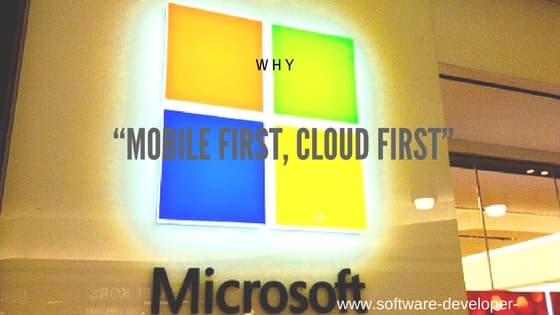Why Microsoft’s Theme Is “Mobile First, Cloud First”
Satya Nadella, the CEO of Microsoft was the author of the concept, mobile first, cloud-first. This eventually became the Microsoft’s mantra. Nadella also coined another term, “ubiquitous computing” probably because of the highly digitalized scenario of the present world. It simply means that computers are everywhere now (ubiquitous computing – computers are embedded everywhere in your business), and if computers are used everywhere, then Microsoft should also be used everywhere. As a prelude to this move, Microsoft made three major things that was instantly accepted and popularized
No more Microsoft license fees for devices and smartphones that were small (the size parameter was 9 inches)
A single suite of Microsoft services including data access and protection, identity and device management
Cross-platform accessibility in Windows, Android and iOS
Meaning of mobile first, cloud-first concept
Customers are on the lookout for two things at a time and they want it quickly, with the endpoints in cloud – communication and content/data. Microsoft intends to create products and services in mobile first, cloud-first concept. When they are designed with mobile first, they are designed with mobile front-ends in view and when they are designed “cloud first”, they are designed with cloud back-ends in view. In a mobile first, cloud-first concept, both complement each other. When it is done with mobile-first view, it thinks about the end points and user interfaces, and the other (cloud first) concentrates on architectural aspect. The products that are designed would be accessible from cloud infrastructure and eliminate the need for a company server. This is greatly helpful and saves on infrastructure. When both the concepts work in co-relation with one another, the needs of both sides are satisfied.
According to Microsoft’s Jason Zander, corporate VP-Cloud and Enterprise, there are three capabilities in its cloud that makes it different from other cloud based services. They are “hybrid, hyper-scale, and enterprise-grade”. True, the concept, mobile first, cloud-first has been around for some time, but it has been considerably sharpened under the present CEO.
Mobile first, cloud-first concept For IT
This complementary technology would definitely be helpful to IT professionals as it is integrated with new tools, services and features. They can access data on any type of device including laptops and IoT sensors. It is quite true that while they can leverage the special benefits offered through cloud based systems, there is also this increased threat of cyber security issues. Microsoft realizes that it has to revamp the old methods and make use of new features that would help detect, respond and protect data from various security threats. All the endpoints are protected, threats are detected and scaled and the response would be devised to be quick because a lot is at stake. Microsoft has been able to put in unique insights into various endpoints; they get trillions of signals from all possible sources to help protect the endpoints from infiltration.
Security issues are addressed
The aim of this technology is to put security first. Idea management is what helps in protecting the data now. This has been greatly helpful because now devices are released into the market with security features integrated into them. You no longer have to bolt them down as additional features. In cloud first, mobile first technology, you have a convergence of data, devices, identities and applications and the main thing that binds them together are Enterprise Mobility Suite (EMS) and Azure Active Directory. Businesses have found this as an answer to their prayers because now they are able to give their customers freedom and flexibility. Both cloud and mobile services can be used by people who are authorized to use them.
At present, the innovations introduced through Microsoft Azure, EMS and Windows 10 works in tandem to provide not just security, but agility as well. These are integrated with an intelligent security graph that would give insights whenever there is an attempt of unauthorized use of your data, password snitching, malware installation and so on. There is also protection against data loss – both accidental and intentional.
Choosing the right cloud and equipment
Understand your business requirements and choose a cloud service that would be able to meet your future needs. Agility and elasticity are the two major requirements for them. If cloud services are agile, it means the IT team can handle the requirements of its customers pretty quickly. The very meaning of agility is to adapt to changes in a cost-effective manner with proper usage of resources. Thankfully, as it is all using cloud-based technologies, there is no need for any kind of physical quarters or any requirements that would lead to single-points-of-failure. Users can work on any computing devices instead of their workstation, just as long as they are able to provide authentification information.
Elasticity in cloud computing means it is possible for you to scale your resources at the simple click of a mouse button. After all, the main benefit of cloud computing is that you can provision computing resources as per the demand. Elasticity could come in the form of power usage, storage or bandwidth consumption.
With cloud first, mobile first concept, it is possible to protect corporate assets, apply policies, empower employees and rest of the workforce and improve security and privacy.
Interesting links about the topic:
Satya Nadella About: Mobile First, Cloud First
Is Microsoft’s ‘Mobile First, Cloud First’ Strategy, Really Working?

The author: Reema Oamkumar is engaged as a thought leader at www.Software-Developer-India.com which is a part of the YUHIRO Group. YUHIRO is a German-Indian enterprise which provides programmers to IT companies, agencies and IT departments.


Leave a Reply